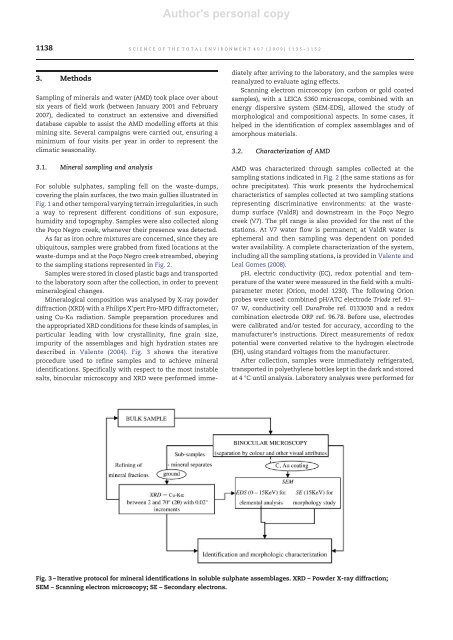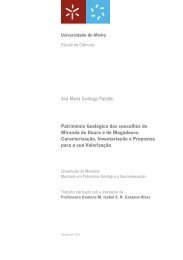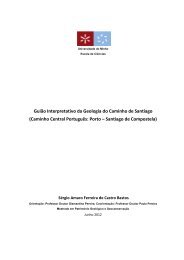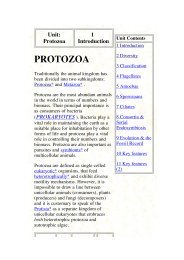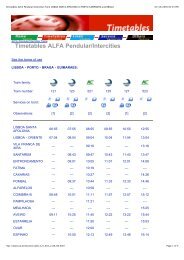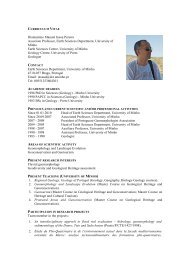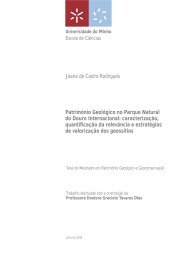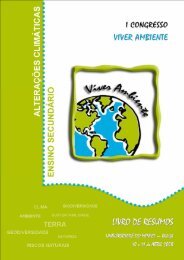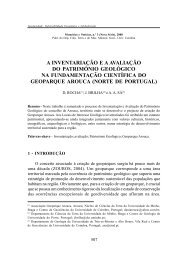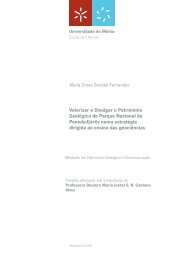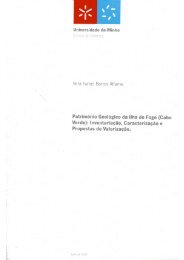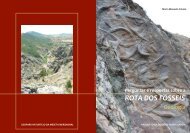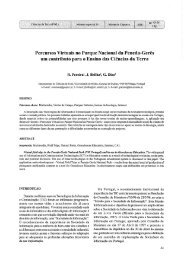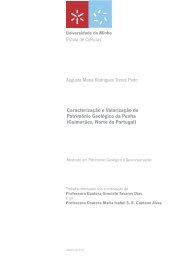Descarregue o Livro do Curso a partir daqui - Departamento de ...
Descarregue o Livro do Curso a partir daqui - Departamento de ...
Descarregue o Livro do Curso a partir daqui - Departamento de ...
Create successful ePaper yourself
Turn your PDF publications into a flip-book with our unique Google optimized e-Paper software.
Author's personal copy<br />
1138 SCIENCE OF THE TOTAL ENVIRONMENT 407 (2009) 1135– 1152<br />
3. Methods<br />
Sampling of minerals and water (AMD) took place over about<br />
six years of field work (between January 2001 and February<br />
2007), <strong>de</strong>dicated to construct an extensive and diversified<br />
database capable to assist the AMD mo<strong>de</strong>lling efforts at this<br />
mining site. Several campaigns were carried out, ensuring a<br />
minimum of four visits per year in or<strong>de</strong>r to represent the<br />
climatic seasonality.<br />
3.1. Mineral sampling and analysis<br />
For soluble sulphates, sampling fell on the waste-dumps,<br />
covering the plain surfaces, the two main gullies illustrated in<br />
Fig. 1 and other temporal varying terrain irregularities, in such<br />
a way to represent different conditions of sun exposure,<br />
humidity and topography. Samples were also collected along<br />
the Poço Negro creek, whenever their presence was <strong>de</strong>tected.<br />
As far as iron ochre mixtures are concerned, since they are<br />
ubiquitous, samples were grabbed from fixed locations at the<br />
waste-dumps and at the Poço Negro creek streambed, obeying<br />
to the sampling stations represented in Fig. 2.<br />
Samples were stored in closed plastic bags and transported<br />
to the laboratory soon after the collection, in or<strong>de</strong>r to prevent<br />
mineralogical changes.<br />
Mineralogical composition was analysed by X-ray pow<strong>de</strong>r<br />
diffraction (XRD) with a Philips X'pert Pro-MPD diffractometer,<br />
using Cu-Kα radiation. Sample preparation procedures and<br />
the appropriated XRD conditions for these kinds of samples, in<br />
particular leading with low crystallinity, fine grain size,<br />
impurity of the assemblages and high hydration states are<br />
<strong>de</strong>scribed in Valente (2004). Fig. 3 shows the iterative<br />
procedure used to refine samples and to achieve mineral<br />
i<strong>de</strong>ntifications. Specifically with respect to the most instable<br />
salts, binocular microscopy and XRD were performed immediately<br />
after arriving to the laboratory, and the samples were<br />
reanalyzed to evaluate aging effects.<br />
Scanning electron microscopy (on carbon or gold coated<br />
samples), with a LEICA S360 microscope, combined with an<br />
energy dispersive system (SEM-EDS), allowed the study of<br />
morphological and compositional aspects. In some cases, it<br />
helped in the i<strong>de</strong>ntification of complex assemblages and of<br />
amorphous materials.<br />
3.2. Characterization of AMD<br />
AMD was characterized through samples collected at the<br />
sampling stations indicated in Fig. 2 (the same stations as for<br />
ochre precipitates). This work presents the hydrochemical<br />
characteristics of samples collected at two sampling stations<br />
representing discriminative environments: at the wastedump<br />
surface (ValdR) and <strong>do</strong>wnstream in the Poço Negro<br />
creek (V7). The pH range is also provi<strong>de</strong>d for the rest of the<br />
stations. At V7 water flow is permanent; at ValdR water is<br />
ephemeral and then sampling was <strong>de</strong>pen<strong>de</strong>nt on pon<strong>de</strong>d<br />
water availability. A complete characterization of the system,<br />
including all the sampling stations, is provi<strong>de</strong>d in Valente and<br />
Leal Gomes (2008).<br />
pH, electric conductivity (EC), re<strong>do</strong>x potential and temperature<br />
of the water were measured in the field with a multiparameter<br />
meter (Orion, mo<strong>de</strong>l 1230). The following Orion<br />
probes were used: combined pH/ATC electro<strong>de</strong> Trio<strong>de</strong> ref. 91–<br />
07 W, conductivity cell DuraProbe ref. 0133030 and a re<strong>do</strong>x<br />
combination electro<strong>de</strong> ORP ref. 96.78. Before use, electro<strong>de</strong>s<br />
were calibrated and/or tested for accuracy, according to the<br />
manufacturer's instructions. Direct measurements of re<strong>do</strong>x<br />
potential were converted relative to the hydrogen electro<strong>de</strong><br />
(EH), using standard voltages from the manufacturer.<br />
After collection, samples were immediately refrigerated,<br />
transported in polyethylene bottles kept in the dark and stored<br />
at 4 °C until analysis. Laboratory analyses were performed for<br />
Fig. 3 – Iterative protocol for mineral i<strong>de</strong>ntifications in soluble sulphate assemblages. XRD – Pow<strong>de</strong>r X-ray diffraction;<br />
SEM – Scanning electron microscopy; SE – Secondary electrons.


